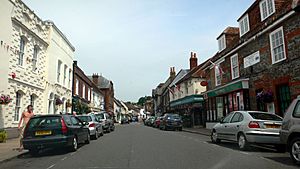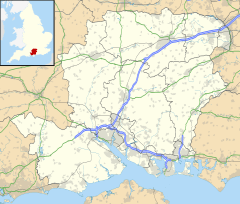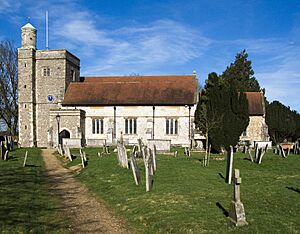Bishop's Waltham facts for kids
Quick facts for kids Bishop's Waltham |
|
|---|---|
| Market town | |
 Bishop's Waltham High Street |
|
| Population | 6,723 (2011 Census) |
| OS grid reference | SU554174 |
| District | |
| Shire county | |
| Region | |
| Country | England |
| Sovereign state | United Kingdom |
| Post town | Southampton |
| Postcode district | SO32 |
| Dialling code | 01489 |
| Police | Hampshire |
| Fire | Hampshire |
| Ambulance | South Central |
| EU Parliament | South East England |
| UK Parliament |
|
Bishop's Waltham is an old market town in Hampshire, England. It sits where the River Hamble begins. The town is partly in the South Downs National Park. It is also halfway between the cities of Winchester and Portsmouth.
Bishop's Waltham is famous for the ruins of Bishop's Waltham Palace. This palace is a very old monument managed by English Heritage. The town also has a well-kept main street with many historic buildings. These buildings now hold unique local shops.
Many kings and queens from the Middle Ages and Tudor times visited the palace. The town's name comes from old Anglo-Saxon words. "Wald" means forest, and "ham" means settlement.
Today, Bishop's Waltham has over 6,700 people. It is the biggest town in the Winchester area, apart from Winchester city itself. The town has both an infant and a junior school.
Contents
- Town History
- Bus Services
- Old Railway Line
- Culture and Fun Things to Do
- The Moors Nature Area
- River Hamble
- Schools in Bishop's Waltham
- Sports and Hobbies
- The Priory
- The Waltham Blacks
- Gunner and Company Bank
- Famous People from Bishop's Waltham
- Old Pubs in Bishop's Waltham
- Abbey Mill
- Images for kids
- See also
Town History
The name Bishop's Waltham tells us about its past. 'Walt' means forest, 'ham' means settlement, and 'Bishop's' refers to a bishop. The town started as an Anglo-Saxon settlement around 450 to 550 AD. It grew into one of Hampshire's biggest villages. Even after Danes burned it down in 1001 AD, it recovered.
By 1086 AD, when the Domesday book was written, about 600 people lived there. This made it the 11th largest settlement in Hampshire. In 904, King Edward the Elder traded the land to the Bishop of Winchester.
Later, in 1136, Bishop Henry de Blois built a new church. In 1158, he started building the Bishop's Waltham Palace. This palace was later destroyed by Oliver Cromwell during the English Civil War. You can still see many parts of the old palace in the town. Its ruins are open for visitors. Some of its stones were even used to build other houses in the town.
William of Wykeham, a famous person, died in Bishop's Waltham. After the Battle of Trafalgar, about 200 French officers were held prisoner here. This included Admiral Villeneuve.
The town has many Georgian buildings. It also has a Norman parish church. Bishop's Waltham has a special feel with its local shops. These include a butcher, a bakery, and a fishmonger. There is even a wine shop that opened in 1617!
The High Street also has some bigger stores. But local shop owners have worked hard to keep the town's unique character. There is also a vineyard nearby, which is unusual for the UK.
In the 1800s, Bishop's Waltham was a busy market town. It had many farms, shops, and a cattle market. There was also a large brick factory and a gasworks. The gasworks provided gas for lighting and heating the town.
The brick factory was a major employer. It started in 1862 as the Bishop's Waltham Clay Company. The factory was in a great spot for clay. It had two main types of clay needed for bricks and tiles. The company also made terracotta products.
Later, the Blanchard family took over the factory in 1871. They invested a lot of money into it. Blanchard terracotta from Bishop's Waltham became very famous. It was known for its bright red color and strength.
Buildings like Buckingham Palace and the Natural History Museum, London used Blanchard terracotta. Their bricks were also used for railway projects. Many Victorian houses in nearby towns were built with these bricks. The factory closed in 1957. Today, the site is an industrial park.
Bus Services
Bishop's Waltham has one main bus stop called The Square. Buses stop here about three times an hour in both directions. Two bus companies, Stagecoach South and Xelabus, serve the town.
Old Railway Line
Bishop's Waltham used to have its own railway line. The Bishops Waltham branch line opened in 1862. It connected the town to Botley. The railway mainly carried goods like bricks and coal. It also had special trains for farmers to bring their cattle to market.
Passenger services stopped in 1932. Goods trains continued until the 1960s. The old station was a unique brick building. It stood where the main roundabout is now. A small part of the old line and some level crossing gates have been saved.
Culture and Fun Things to Do
Bishop's Waltham is twinned with Saint-Bonnet-le-Château in France. The Palace grounds often host festivals and other events. The town also has a small museum.
The Bishop's Waltham Youth Theatre is a group for young people. It is run by local theatre directors.
The Moors Nature Area
The Moors, Bishop's Waltham is a very special nature area. It is a Site of Special Scientific Interest. This means it is important for its plants and animals. It has unique wet areas and open water. Many different types of habitats and rare species live here.
The area includes about 34 hectares of wet land. It has streams and drains that flow into Waltham Mill Pond. The 'Sand Boils' is a spot where spring water bubbles up, making sandy patches in the stream bed. Water from the mill pond then flows into the River Hamble.
Dundridge Meadows is another nature reserve near Bishop's Waltham. It covers about 7.5 hectares.
River Hamble
Bishop's Waltham is in the Hamble Valley. The River Hamble starts at Northbrook, on the north side of town. The river flows south through two ponds. It then goes towards Botley. The Moors Stream joins it on the southern edge of Bishop's Waltham. The river continues through Curdridge. It becomes a tidal estuary at Fairthorne.
Schools in Bishop's Waltham
Bishop's Waltham Junior School opened in 1969. In 2017, it was rated 'Good' by Ofsted. This school is for children aged 7 to 11. Its students usually go on to Swanmore College.
Bishop's Waltham Infant School was rated 'Outstanding' by Ofsted in 2011. It is for children aged 4 to 7.
Lilypad Pre-School is on the same site. Bishop's Waltham Montessori is also in town. It was rated 'Outstanding' by Ofsted in 2016.
Sports and Hobbies
Bishop's Waltham has a big youth football club called Bishop's Waltham Dynamos. They use the fields at Priory Park. The Dynamos started in 1975. They are now one of the biggest junior football clubs in Hampshire.
Bishop's Waltham Cricket Club has three teams in the Hampshire Cricket League. They also have junior teams. Their ground is at the end of Albany Road.
The town has two tennis courts at Hoe Road Recreation Ground. Children can get coaching on Sunday mornings.
The Priory
The Priory is a large red-brick house in Newtown. It was built in the 1860s as a hospital. Sir Arthur Helps gave the land for it. Prince Leopold laid the first stone in 1864.
The Waltham Blacks
The Waltham Blacks were a group of deer poachers. They were known for stealing deer and causing trouble. A special law, the Black Act 1723, was passed in 1723 to stop them. This law made it a serious crime to appear armed or disguised to hunt deer or steal fish.
Gunner and Company Bank
Gunner and Company was a private bank in Bishop's Waltham. It started in 1809. It was the main bank for the town and the Meon Valley for much of the 1800s. It was the last private bank in the UK from 1921 until 1953. Then, Barclays Bank bought it.
Famous People from Bishop's Waltham
- Henry of Blois (1098/9 – 1171): He was a bishop of Winchester. He was also the younger brother of King Stephen.
- Amanda Holden: A well-known actress and TV presenter.
- Sir William Jenner, 1st Baronet: He was a doctor to Queen Victoria.
- Admiral of the Fleet Andrew Cunningham, 1st Viscount Cunningham of Hyndhope.
- Dr Samuel Ward: He helped translate the King James Bible. He was buried in Bishop's Waltham in 1629.
- Admiral Edward Vernon (1684–1757): He built Vernon Hill House near the town.
- Sir William Parry (1790–1855): This Arctic explorer lived at Northbrook House.
- Reverend George Marshall (1753–1819): He helped promote education for poor people.
Old Pubs in Bishop's Waltham
Bishop's Waltham has a history of many pubs and inns. Some of them were very old coaching inns.
- The Crown Inn: Parts of this hotel date back to the 1500s. It used to be a coaching inn with stables.
- The Mafeking Hero: This was a 17th-century coaching inn. It was renamed in 1900 to honor local men who survived a siege in South Africa. It is now a restaurant.
- The Barleycorn: This building has oak beams and dates from the 1600s. It was once thought to be a brewery.
- The Bunch of Grapes: This pub dates from the 1500s. It is on one of Bishop's Waltham's prettiest streets.
- The Priory Inn: This pub used to be called The Railway Inn. This was because it was close to the old railway station.
Many other pubs have closed over the years. Some have become shops or restaurants.
Abbey Mill
Abbey Mill was built in 1862. It was a working mill for many years. The Duke Family ran it until the business closed around 2005. The milling work moved to another site. Abbey Mill was then used for offices. It was planned to become a supermarket, but that did not happen. The site is now for sale.
Images for kids
See also
 In Spanish: Bishop's Waltham para niños
In Spanish: Bishop's Waltham para niños




